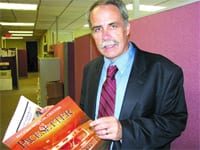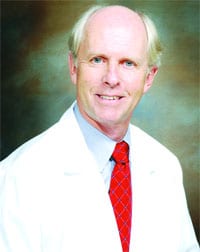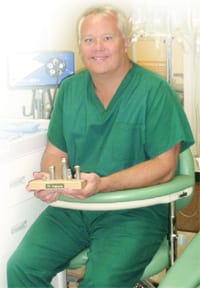Pressing Issues Holyoke Medical Center’s Community Magazine Marks 25 Years
Kevin O’Hare says Holyoke Medical Center’s community magazine has been setting the pace among area hospitals for a quarter-century.
“At the time, as I recall, we were the first hospital doing something like this,” O’Hare said of the original concept of Pacesetter, which debuted in November 1985. That initial idea was to bring information about the hospital and health topics to a dual readership of both employees and the general public. “We had it inserted into newspapers, things like that, because we wanted to reach a wider audience.
“It’s evolved a lot through the years,” said O’Hare, HMC’s public relations director and Pacesetter’s editor, “but it’s still both a community publication and an employee publication … but it’s geared more for the community these days. We want our employees and physicians to know about the things happening here, and this is certainly a good vehicle for that, but in terms of sheer numbers, the vast majority of these are going to people living in our service area, and even a little bit beyond it.”
O’Hare said the magazine, which is produced five times per year, serves several purposes — not only keeping employees and the community informed about key health topics, but marketing the hospital’s services in a more targeted, budget-friendly way than media advertising.
“In a hospital like ours, we have limited resources. I think our fiscal issues have been pretty well-known to most people paying attention in Western Mass. over the past few years,” O’Hare said. “We are in a community that has struggled, and we have struggled with low reimbursement rates. We don’t have the luxury of some of the advertising that other folks might have at the current time.
“So it’s really important for us to get things out to the community in as cost-effective a way as possible,” he continued. “We’ve found this to be extremely cost-effective, and our readership surveys indicate that each issue is read by approximately 100,000 people. We’re very pleased with those numbers.”
Something for Everyone
As he flipped through a recent issue, O’Hare highlighted how Pacesetter connects with the community, explaining that the first three-quarters of each 16- or 20-page issue is filled with stories that would be of interest to the general public while drawing attention to specific HMC services — in this case, pieces on the Speech and Hearing Center, coping with anxiety (which highlights the Outpatient Behavioral Health Service), and new options for lymphedema therapy (featuring the Occupational Therapy department), among other features.
HMC President Hank Porten also writes a column for each Pacesetter — in this particular issue, touting the Emergency Department, which treats about 45,000 patients annually, making it an entry point for a vast swath of those who arrive at the hospital each year.
“He might do updates on construction projects, maybe a column on how the hospital gives back to the community,” O’Hare said. “In the next issue, he writes about Medicaid reimbursements.”
Deeper into Pacesetter, readers begin to encounter stories more narrowly targeted to hospital employees — key staff appointments (in the most recent issue, a new chief of Pediatrics), employees of the month, and “60 Second Interviews” with staffers, for instance. But even these are written in an engaging style meant to appeal to the general public, O’Hare said.
“They’re a little lighter, such as an ‘After Hours’ piece in every issue which talks about things employees do when they’re not working,” O’Hare said, pointing to the recent profile of Development Director Sean Mitchell, who took up cycling five years ago for health reasons and found he had a passion for it. “We do pieces on people who are photographers, marathon runners, artists, people in bands … there are a million things people do when they’re not working that are pretty fascinating.”
Pacesetter also includes a “Where Are They Now?” piece on former employees. “We feel that’s really valuable in extending the feel that this is a family here, and when you’re gone, you’re not forgotten,” O’Hare said. “We want to highlight people who played a major role here over the past 20, 25 years. Sometimes we’ll look back even further than that. Sometimes we feature retirees, and other times people who have left the area or moved on to a completely different field.”
Breezy features like these are meant to draw people into the more substantive health care articles, O’Hare said, adding that “we focus a lot of the general health news on things we feel we do particularly well.
“The reality is, we’re a mid-sized community hospital. We have great people here, about 1,200 employees and a medical staff upwards of 250 doctors, and there’s a lot of stuff that goes on here that people don’t know about,” he continued, noting that the upcoming issue contains stories about key accreditations for the hospital’s Stroke Center and Breast Center that set them apart from other area hospitals.
Finally, each issue of Pacesetter contains a community calendar of health-education programs (like the hospital’s Dessert with the Docs series), support groups, and other events, as well as news from HMC’s affiliates, the Holyoke Visiting Nurse Assoc. and River Valley Counseling Center.
Patients First
Pacesetter gets distributed to a mailing list and is sometimes inserted into the Republican or the Holyoke Sun. It’s sent to targeted ZIP codes, occasionally extending beyond the hospital’s typical patient base into other communities if a service is featured that can be marketed there.
“We also have added it online now, at holyokehealth.com, if you prefer that,” O’Hare said, “and we’re certainly exploring electronic avenues more and more, but there’s still a strong foundation of people in this area who still want to read a newsmagazine format.”
No matter what the story, O’Hare said, “we always try to include patient quotes wherever possible. Yes, when you talk about a piece of equipment, you want to know what it does, what it costs, if it has the greatest bells and whistles, but, more important, what does it do for the patient?
“That tends to be our focus in everything we write, and we try to include it — not late in the article, but right up front if possible,” he continued. “What does it do for the patient and for the physician treating the patient? New equipment can be an arms race something when it comes to what hospital has this equipment, what hospital has that equipment, what this costs, what that costs. But the bottom line is, what does it do for the patient?”
Pacesetter has been answering that question for 25 years.




Comments are closed.